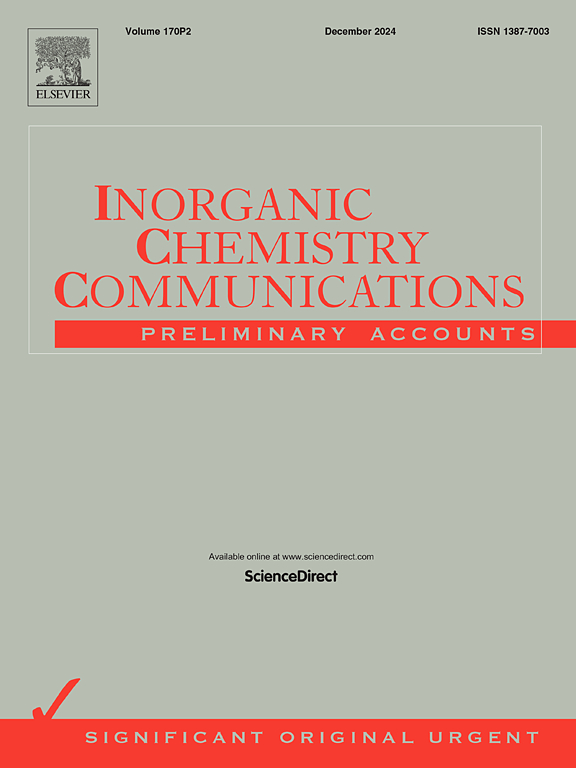Facile hydrothermal synthesis of Gd-doped carbon quantum dots for dual-mode colorimetric and photoluminescence sensing of Hg2+ ions with potential real samples and bioimaging applications
IF 4.4
3区 化学
Q1 CHEMISTRY, INORGANIC & NUCLEAR
引用次数: 0
Abstract
Carbon quantum dots (CQDs) are luminous, nearly spherical nanoparticles known for their water solubility, excellent biocompatibility, and adjustable chemical and physical characteristics, making them suitable for diverse applications. In this work, Gadolinium-doped carbon quantum dots (Gd-CQDs) were synthesized by hydrothermal method with gadolinium used as metal source, citric acid and melamine precursor used as a carbon and nitrogen source. The as-prepared Gd-CQDs were characterized by using UV–Vis, photoluminescence (PL), FTIR, XRD, HRTEM, and XPS analysis. The Gd-CQDs exhibited strong UV–Vis absorption peaks at 293 nm and 367 nm, with a photoluminescence (PL) emission at 526 nm and a fluorescence quantum yield of 19.7 % with an average size was 3.21 ± 0.3 nm. A novel dual-readout sensor, based on Gd-CQDs were also tested as colorimetric and PL sensors for the highly selective and sensitive detection of mercury ions (Hg2+). Upon interaction with Hg2+ ions, the sensing Gd-CQDs solution transitions from yellow to colorless is observable by the naked eye, while its PL remains quenched. The colorimetric and PL response to Hg2+ ions is good linear in the ranges between 0 and 50 μM, and the limit of detection (LOD) are 104.4 nM in case of colorimetry and 60.2 nM in case of PL. The reversibility of the sensor was also evaluated, revealing a retention of 90 % efficiency after 10 cycles. In biological assays, the Gd-CQDs exhibited negligible cytotoxicity, with cell viability exceeding 94 %, and were successfully used for bioimaging of Hg2+ ions in HCT-116 cells. Moreover, real water sample analysis demonstrated high accuracy in Hg2+ detection, with recovery rates ranging from 98.9 % to 103.8 % and relative standard deviations (RSD) between 0.36 % and 2.32 %. These results highlight the Gd-CQDs as a highly effective, stable, and selective probe for Hg2+ ions detection in environmental and biological applications.
水热合成gd掺杂碳量子点用于Hg2+离子的双模比色和光致发光传感,具有潜在的实际样品和生物成像应用
碳量子点(CQDs)是一种发光的、接近球形的纳米颗粒,以其水溶性、优异的生物相容性和可调节的化学和物理特性而闻名,使其适用于各种应用。以钆为金属源,柠檬酸和三聚氰胺前体为碳源和氮源,采用水热法制备了掺杂钆的碳量子点(Gd-CQDs)。采用紫外可见光谱(UV-Vis)、光致发光(PL)、红外光谱(FTIR)、x射线衍射(XRD)、HRTEM和XPS分析对所制备的Gd-CQDs进行了表征。Gd-CQDs在293 nm和367 nm处有较强的紫外-可见吸收峰,在526 nm处有发光,荧光量子产率为19.7%,平均尺寸为3.21±0.3 nm。本文还对基于Gd-CQDs的新型双读出传感器进行了测试,该传感器可作为比色和PL传感器用于高选择性和高灵敏度的汞离子(Hg2+)检测。在与Hg2+离子相互作用后,传感Gd-CQDs溶液由黄色变为无色,肉眼可见,而其PL仍处于淬灭状态。在0 ~ 50 μM范围内,该传感器对Hg2+离子的比色和荧光响应呈良好的线性关系,检出限(LOD)在比色下为104.4 nM,在荧光下为60.2 nM。该传感器的可逆性也被评估,显示10次循环后效率保持在90%。在生物实验中,Gd-CQDs表现出可以忽略不计的细胞毒性,细胞存活率超过94%,并成功用于HCT-116细胞中Hg2+离子的生物成像。实际水样中Hg2+的检测准确度较高,回收率为98.9% ~ 103.8%,相对标准偏差(RSD)为0.36% ~ 2.32%。这些结果强调了Gd-CQDs作为一种高效、稳定、选择性强的Hg2+探针在环境和生物领域的应用。
本文章由计算机程序翻译,如有差异,请以英文原文为准。
求助全文
约1分钟内获得全文
求助全文
来源期刊

Inorganic Chemistry Communications
化学-无机化学与核化学
CiteScore
5.50
自引率
7.90%
发文量
1013
审稿时长
53 days
期刊介绍:
Launched in January 1998, Inorganic Chemistry Communications is an international journal dedicated to the rapid publication of short communications in the major areas of inorganic, organometallic and supramolecular chemistry. Topics include synthetic and reaction chemistry, kinetics and mechanisms of reactions, bioinorganic chemistry, photochemistry and the use of metal and organometallic compounds in stoichiometric and catalytic synthesis or organic compounds.
 求助内容:
求助内容: 应助结果提醒方式:
应助结果提醒方式:


